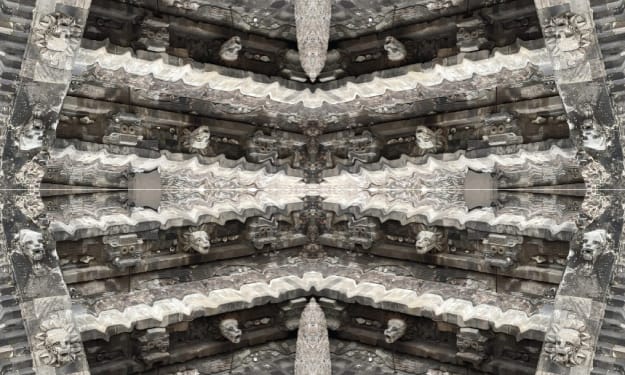The Great Art Of All Times
The Love For Art

This first stage takes place in the cingulate cortex of the posterior cingulate of the brain, which deals with thinking logically and understanding concepts. So, there is enough evidence to suggest we enjoy a puzzle. And art supplies a much greater stimulus to the mind than other types of puzzles.
I draw in between tasks. I sketch at the coffee shop before work. And I like challenging myself to complete a zine — a little magazine — on my 20-minute bus commute.
Art is also now academic. Genres like conceptual art can be intellectually stimulating and enjoyable at that level. Although these pieces essentially require analysis to enjoy, everyone experiences a primal response to them.
That made me wonder: What is going on in my brain when I draw? Why does it feel so nice? And how can I get other people — even if they don't consider themselves artists — on the creativity train?
There isn’t a quick-fix or life hack to making people care about what you are making. Here's the truth: it’s all in your mindset, and that can be a much more obtuse, intangible thing to pin down. If you really want to make people stop and pay attention to what you are doing, go into the studio with the following “inner rules” in mind.
People have been relying on the arts for communication, self-expression, and healing for thousands of years. But art therapy didn't start to become a formal program until the 1940s.
In my own work, that is true throughout the process. At the beginning, developing the basic raw materials for the work is deeply reflective and informative. Later, bringing those materials together into a form—distilling and shaping movement, creating a context, working to something that feels cohesive and complete. That’s incredibly powerful for me—something that really keeps me going.
Doctors noted that individuals living with mental illness often expressed themselves in drawings and other artworks, which led many to explore the use of art as a healing strategy. Since then, art has become an important part of the therapeutic field and is used in some assessment and treatment techniques.
First of all, what is art? The definition for art that I have come up with, which seems to work best for me, is that anything anyone calls art is art. This comes from my belief that there is nothing intrinsic about art. We cannot do a chemical analysis to determine if something is art or not. Instead, I feel like calling something “art” is really just a subjective way of indicating value—which could be aesthetic, cultural, monetary, and so on.
Most of us know the feeling of being moved by a work of art, whether it is a song, a play, a poem, a novel, a painting, or a spatio-temporal experiment. When we are touched, we are moved; we are transported to a new place that is, nevertheless, strongly rooted in a physical experience, in our bodies. We become aware of a feeling that may not be unfamiliar to us but which we did not actively focus on before. This transformative experience is what art is constantly seeking.
I believe that one of the major responsibilities of artists – and the idea that artists have responsibilities may come as a surprise to some – is to help people not only get to know and understand something with their minds but also to feel it emotionally and physically. By doing this, art can mitigate the numbing effect created by the glut of information we are faced with today, and motivate people to turn thinking into doing.
I make art for a few reasons. In life, we experience so much fragmentation of thought and feeling. For me, creating art brings things back together.
Art forces humans to look beyond that which is necessary to survive and leads people to create for the sake of expression and meaning. Through much discussion and some arguing, the group concluded that the arts are necessary to give meaning to things. The sciences provide the facts and information that give order to our world and are at the vanguard of innovation and human achievement.
The purpose of art has been debated for ages. While some view it solely as a form of entertainment, others see it as a vital part of human existence. Art stands out from mere design or craft because it isn't bound by functionality. It offers a unique means of expression, allowing us to convey complex emotions and ideas that words might fail to capture.
Whether you specialize in ballet, piano, or oil painting, you know what it’s like to fall in love with art. The importance of art in society can’t be overstated, and it transcends far beyond borders or cultures. This is what we know about its major tangible and intangible benefits.
When someone applies for a job, there are certain hard skills they need to have like data analysis or bookkeeping. However, many employers also understand the very important need for soft skills.
Visual art is a fundamental component of the human experience reflecting the world and the time in which we live. Art can help us understand our history, our culture, our lives, and the experience of others in a manner that cannot be achieved through other means. It can also be a source of inspiration, reflection, and joy.
These intangible attributes are hard to measure and often difficult to define. Some examples include a person’s ability to adapt to change, think creatively, or collaborate with team members.
Author
About the Creator
SINDILE LANCELOTT TOTOBA
I'm the developer & running the Github United People Organization at Github I write, because I want to reach the end of my imagination and then break through it. I write with the hope that my words & hope will people cry & cheer and dream.
Enjoyed the story? Support the Creator.
Subscribe for free to receive all their stories in your feed. You could also pledge your support or give them a one-off tip, letting them know you appreciate their work.






Comments
There are no comments for this story
Be the first to respond and start the conversation.